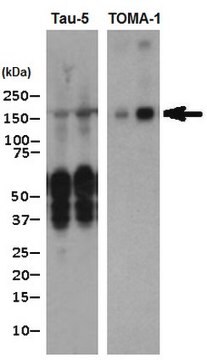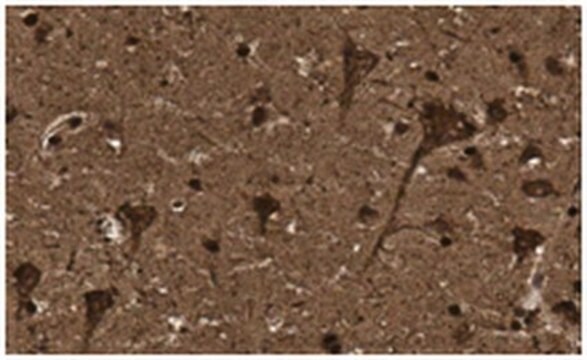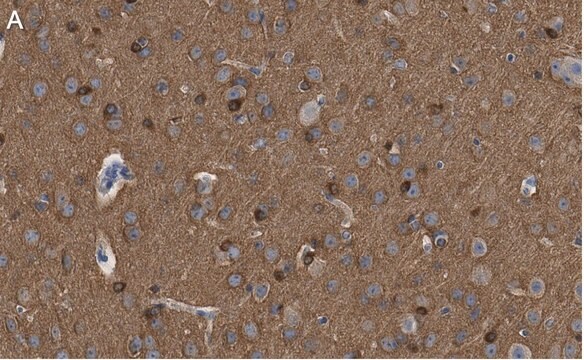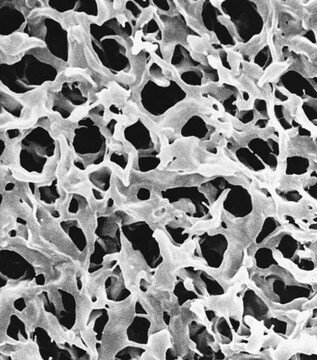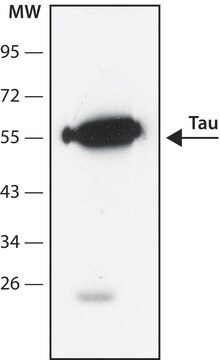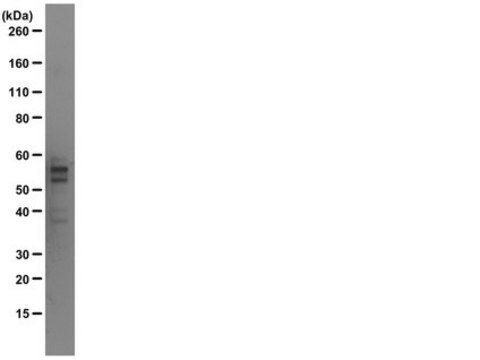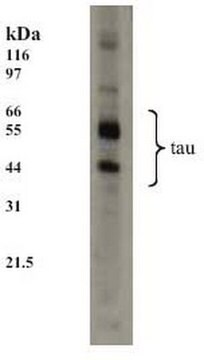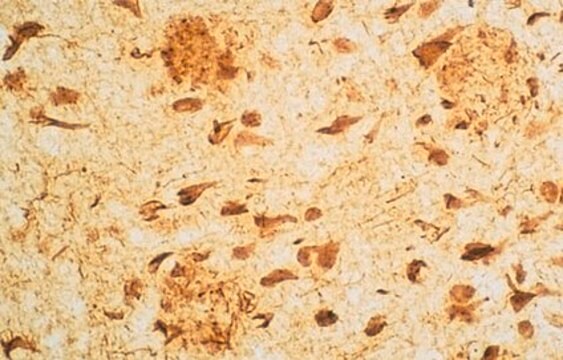추천 제품
제품명
Anti-Tau (T22) Antibody, oligomeric, from rabbit, purified by affinity chromatography
생물학적 소스
rabbit
Quality Level
항체 형태
affinity isolated antibody
항체 생산 유형
primary antibodies
클론
polyclonal
정제법
affinity chromatography
종 반응성
human
기술
dot blot: suitable
immunofluorescence: suitable
immunohistochemistry: suitable
western blot: suitable
NCBI 수납 번호
UniProt 수납 번호
배송 상태
ambient
타겟 번역 후 변형
unmodified
유전자 정보
human ... MAPT(4137)
일반 설명
Microtubule-associated protein tau (UniProt P10636; also known as Neurofibrillary tangle protein, Paired helical filament-tau, PHF-tau) is encoded by the MAPT (also known as TAU, MAPT1, MTBTL) gene (Gene ID 4137) in human. In Alzheimer′s disease (AD) pathology, accumulation of the microtubule-associated protein tau takes place primarily in the neurons. Tau accumulates in both the somatodendritic and axonal domains of neurons. Tau also accumulates in the soma as neurofibrillary tangles (NFTs). Cell death and synaptic lesions occur independently of NFT formation, and research indicates that NFT formation alone is insufficient for neurodegeneration, suggesting that soluble tau aggregates may be the more toxic and pathologically significant tau species. Tau oligomers are neurotoxic when applied extracellularly to cultured neuronal cells, and tau oligomers (but not fibrils) induce neurodegeneration and synaptic and mitochondrial dysfunction in vivo. Moreove, researchers are able to use tau oligomers as a reliable biomarker to differentiate AD brains from age-matched non-AD brains.
특이성
T22 specifically recognizes and neutralizes oligomeric tau, T22 does not show any significant reactivity toward monomeric tau, tau fibrils, Aβ oligomers, Aβ fibrils, α-synuclein oligomers, or α-synuclein fibrils (Lasagna-Reeves, C. A., et al. (2012). FASEB J. 26(5):1946-1959).
면역원
Recombinant human Tau-441 (Tau-F, Tau-4, 2N4R isoform) oligomers (Lasagna-Reeves, C. A., et al. (2012). FASEB J. 26(5):1946-1959).
애플리케이션
Research Category
Neuroscience
Neuroscience
This rabbit polyclonal Anti-Tau (T22), oligomeric, Cat. No. ABN454-I detects levels of Tau oligomers, and has been published and validated for use in Dot Blot, Immunofluorescence, Immunohistochemistry and Western Blotting.
Western Blotting Analysis: 4-6.67 µg/mL from a representative lot detected tau oligomers in frontal cortex tissue lysates from Alzheimer′s diseased (AD), but not from age-matched non-AD, human brains (Courtesy of Prof. Rakez Kayed, University of Texas, Galveston).
Dot Blot Analysis: A representative lot detected human P301S tau oligomers in hippocampal dentate gyrus (DG) and medial entorhinal cortex (MEC) tissue lysates from PS19 transgenic mice. Daily N-SMase Inhibitor GW4869 i.p. injection reduced tau oligomer accumulation in DG, but not MEC (Asai, H., et al. (2015). Nat. Neurosci. 18(11):1584-1593).
Dot Blot Analysis: A representative lot detected increased tau oligomers formation in Alzheimer′s diseased (AD) as well as in aged non-AD human medial temporal gyrus tissue lysates (Blair, L.J., et al. (2013). J. Clin. Invest. 123(10):4158-4169).
Immunohistochemistry Analysis: A representative lot detected human tau oligomers formation in paraffin-embedded striatal sections of Huntington s diseased brains (Vuono, R., et al. (2015). Brain. 138(Pt 7):1907-1918).
Immunohistochemistry Analysis: A representative lot detected increased human tau P301L mutant oligomers formation in CA3 region of Tg4510 mice following FKBP51-expressing AAV viarl particles injection using 4% paraformaldehyde-fixed free-floating brain sections (Blair, L.J., et al. (2013). J. Clin. Invest. 123(10):4158-4169).
Immunofluorescence Analysis: A representative lot detected granule cell layer (GCL) neurons containing oligomers of virally expressed human P301L mutant tau 1 441 by fluorescent immunohistochemistry staining of brain sections from mice received recombinant viral injection to the medial entorhinal cortex (MEC) (Asai, H., et al. (2015). Nat. Neurosci. 18(11):1584-1593).
Immunofluorescence Analysis: A representative lot detected greatly enhanced tau oligomers co-localized with that of oxidative nucleic acid damage marker 8-OH(d)G in human AD brain, as well as heat stress- (HS-) induced Tau oligomers formation in the brain CA1 region of THY-Tau22 transgenic mice expressing human tau with G272V and P301S mutation by fluorescent immunohistochemistry staining of paraffin-embedded brain tissue sections (Violet, M., et al. (2015). Neurobiol. Dis. 82:540-551).
Western Blotting Analysis: A representative lot detected human P301S tau oligomers-containing exosomal fractions from PS19 transgenic mice. Dietary supplementation with CSF-1R Inhibitor PLX3397 reduced exosomal tau oligomer accumulation (Asai, H., et al. (2015). Nat. Neurosci. 18(11):1584-1593).
The unpurified antiserum (Cat. No. ABN454) is also available for dot blot, ELISA, immunofluorescence, immunohistochemistry, immunoprecipitation, neutralization, and Western blotting applications.
Dot Blot Analysis: A representative lot detected human P301S tau oligomers in hippocampal dentate gyrus (DG) and medial entorhinal cortex (MEC) tissue lysates from PS19 transgenic mice. Daily N-SMase Inhibitor GW4869 i.p. injection reduced tau oligomer accumulation in DG, but not MEC (Asai, H., et al. (2015). Nat. Neurosci. 18(11):1584-1593).
Dot Blot Analysis: A representative lot detected increased tau oligomers formation in Alzheimer′s diseased (AD) as well as in aged non-AD human medial temporal gyrus tissue lysates (Blair, L.J., et al. (2013). J. Clin. Invest. 123(10):4158-4169).
Immunohistochemistry Analysis: A representative lot detected human tau oligomers formation in paraffin-embedded striatal sections of Huntington s diseased brains (Vuono, R., et al. (2015). Brain. 138(Pt 7):1907-1918).
Immunohistochemistry Analysis: A representative lot detected increased human tau P301L mutant oligomers formation in CA3 region of Tg4510 mice following FKBP51-expressing AAV viarl particles injection using 4% paraformaldehyde-fixed free-floating brain sections (Blair, L.J., et al. (2013). J. Clin. Invest. 123(10):4158-4169).
Immunofluorescence Analysis: A representative lot detected granule cell layer (GCL) neurons containing oligomers of virally expressed human P301L mutant tau 1 441 by fluorescent immunohistochemistry staining of brain sections from mice received recombinant viral injection to the medial entorhinal cortex (MEC) (Asai, H., et al. (2015). Nat. Neurosci. 18(11):1584-1593).
Immunofluorescence Analysis: A representative lot detected greatly enhanced tau oligomers co-localized with that of oxidative nucleic acid damage marker 8-OH(d)G in human AD brain, as well as heat stress- (HS-) induced Tau oligomers formation in the brain CA1 region of THY-Tau22 transgenic mice expressing human tau with G272V and P301S mutation by fluorescent immunohistochemistry staining of paraffin-embedded brain tissue sections (Violet, M., et al. (2015). Neurobiol. Dis. 82:540-551).
Western Blotting Analysis: A representative lot detected human P301S tau oligomers-containing exosomal fractions from PS19 transgenic mice. Dietary supplementation with CSF-1R Inhibitor PLX3397 reduced exosomal tau oligomer accumulation (Asai, H., et al. (2015). Nat. Neurosci. 18(11):1584-1593).
The unpurified antiserum (Cat. No. ABN454) is also available for dot blot, ELISA, immunofluorescence, immunohistochemistry, immunoprecipitation, neutralization, and Western blotting applications.
품질
Evaluated by Dot Blot analysis of recombinant human tau.
Dot Blot Analysis: 2 µg/mL of this antibody detected 100 ng of in vitro generated recombinant human tau oligomers, but not tau monomer.
Dot Blot Analysis: 2 µg/mL of this antibody detected 100 ng of in vitro generated recombinant human tau oligomers, but not tau monomer.
표적 설명
Variable depending on the size(s) of the oligomer(s). Uncharacterized bands may be observed in some lysate(s).
물리적 형태
Affinity purified.
Purified rabbit polyclonal antibody in PBS without preservatives.
저장 및 안정성
Stable for 1 year at -20°C from date of receipt.
Handling Recommendations: Upon receipt and prior to removing the cap, centrifuge the vial and gently mix the solution. Aliquot into microcentrifuge tubes and store at -20°C. Avoid repeated freeze/thaw cycles, which may damage IgG and affect product performance.
Handling Recommendations: Upon receipt and prior to removing the cap, centrifuge the vial and gently mix the solution. Aliquot into microcentrifuge tubes and store at -20°C. Avoid repeated freeze/thaw cycles, which may damage IgG and affect product performance.
기타 정보
Concentration: Please refer to lot specific datasheet.
면책조항
Unless otherwise stated in our catalog or other company documentation accompanying the product(s), our products are intended for research use only and are not to be used for any other purpose, which includes but is not limited to, unauthorized commercial uses, in vitro diagnostic uses, ex vivo or in vivo therapeutic uses or any type of consumption or application to humans or animals.
적합한 제품을 찾을 수 없으신가요?
당사의 제품 선택기 도구.을(를) 시도해 보세요.
Storage Class Code
12 - Non Combustible Liquids
WGK
WGK 2
Flash Point (°F)
Not applicable
Flash Point (°C)
Not applicable
시험 성적서(COA)
제품의 로트/배치 번호를 입력하여 시험 성적서(COA)을 검색하십시오. 로트 및 배치 번호는 제품 라벨에 있는 ‘로트’ 또는 ‘배치’라는 용어 뒤에서 찾을 수 있습니다.
자사의 과학자팀은 생명 과학, 재료 과학, 화학 합성, 크로마토그래피, 분석 및 기타 많은 영역을 포함한 모든 과학 분야에 경험이 있습니다..
고객지원팀으로 연락바랍니다.
